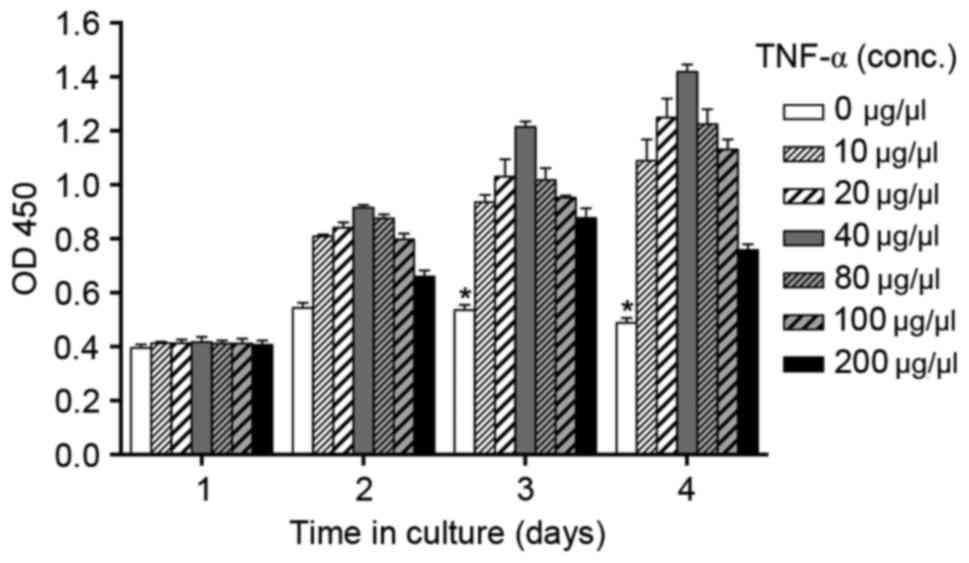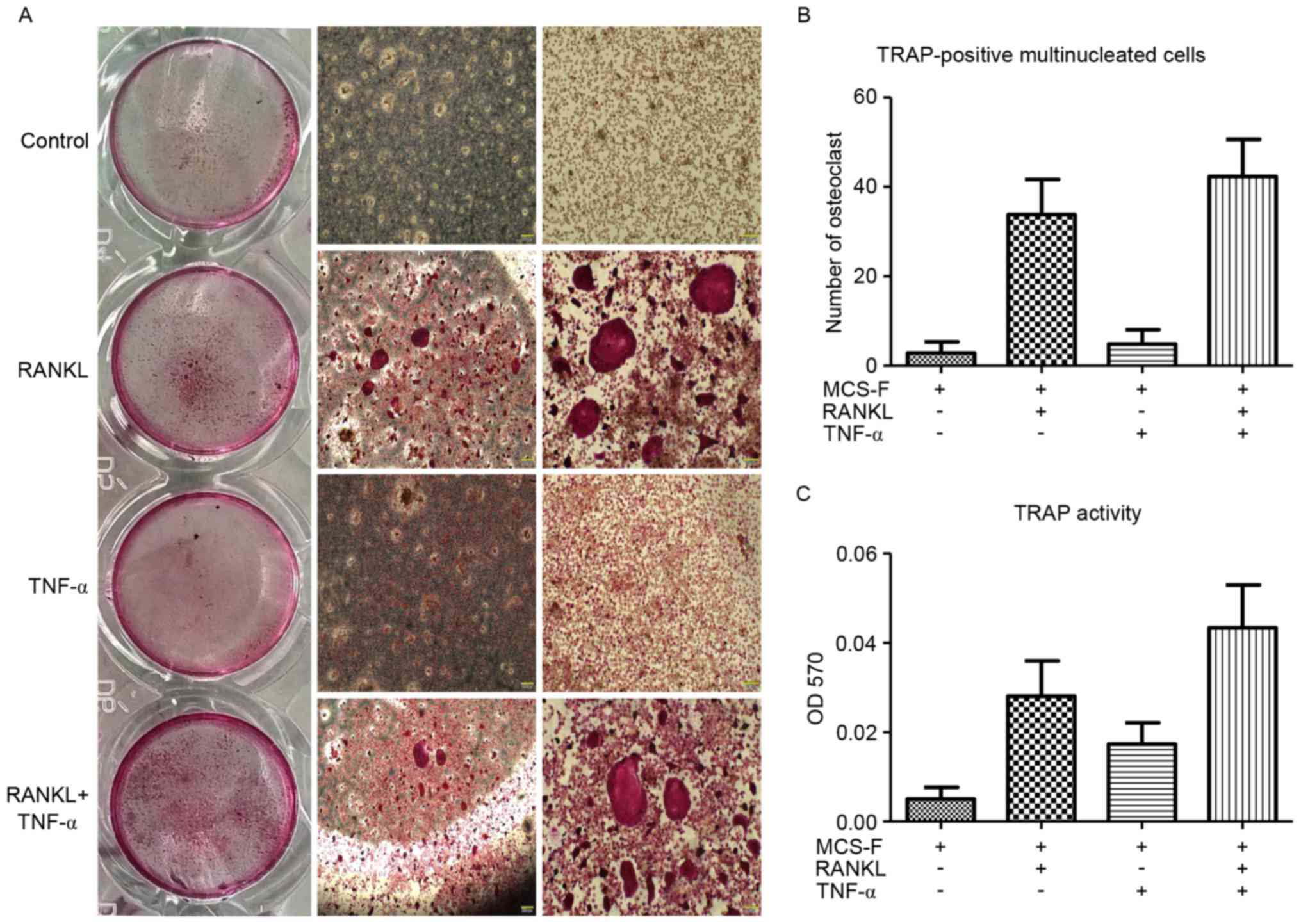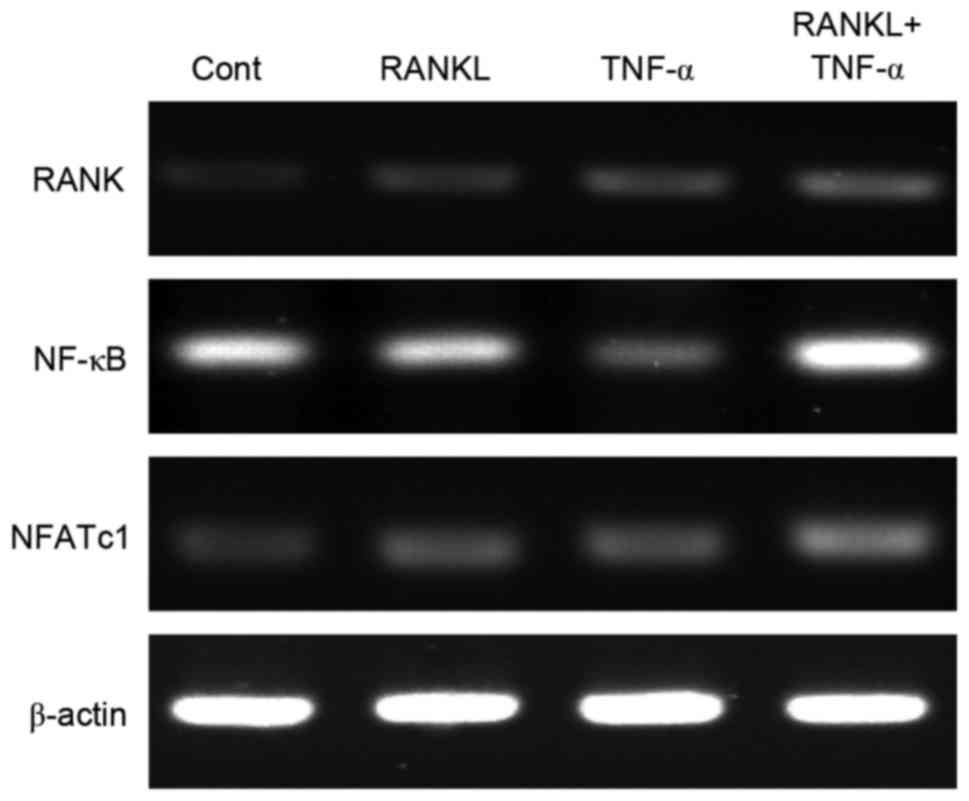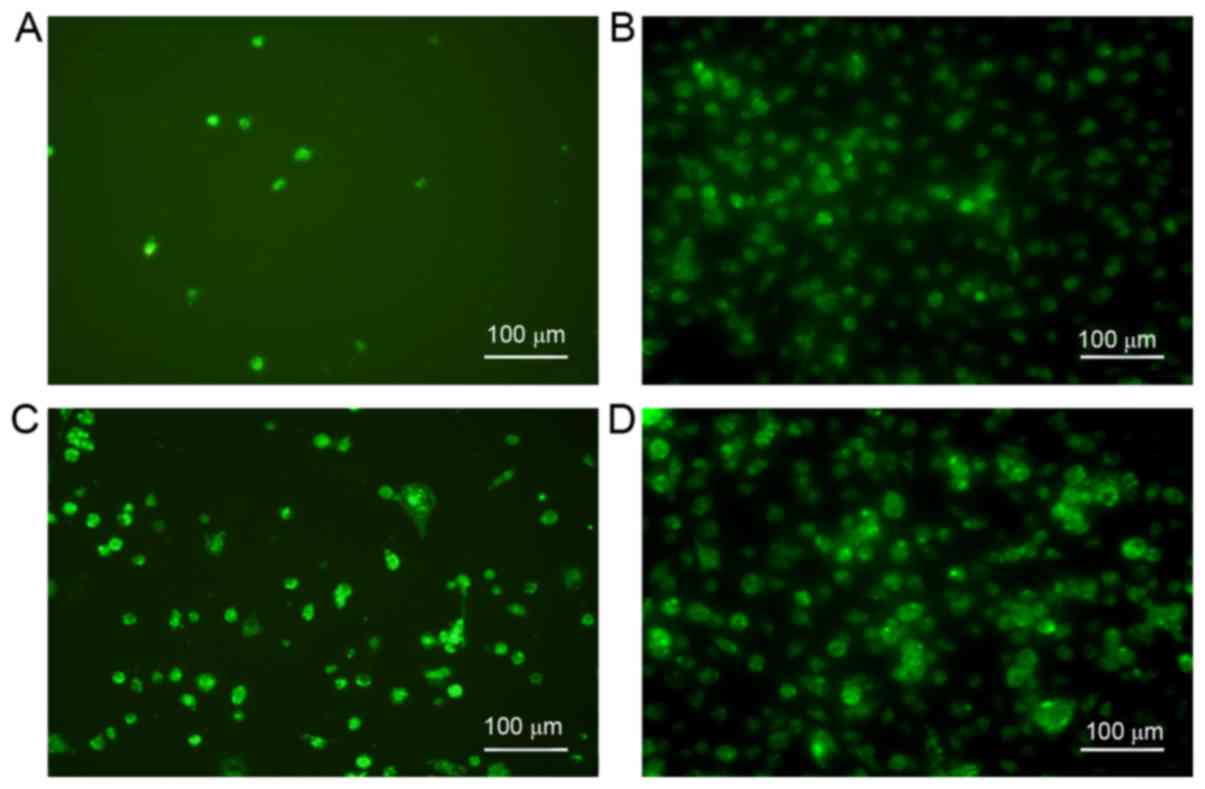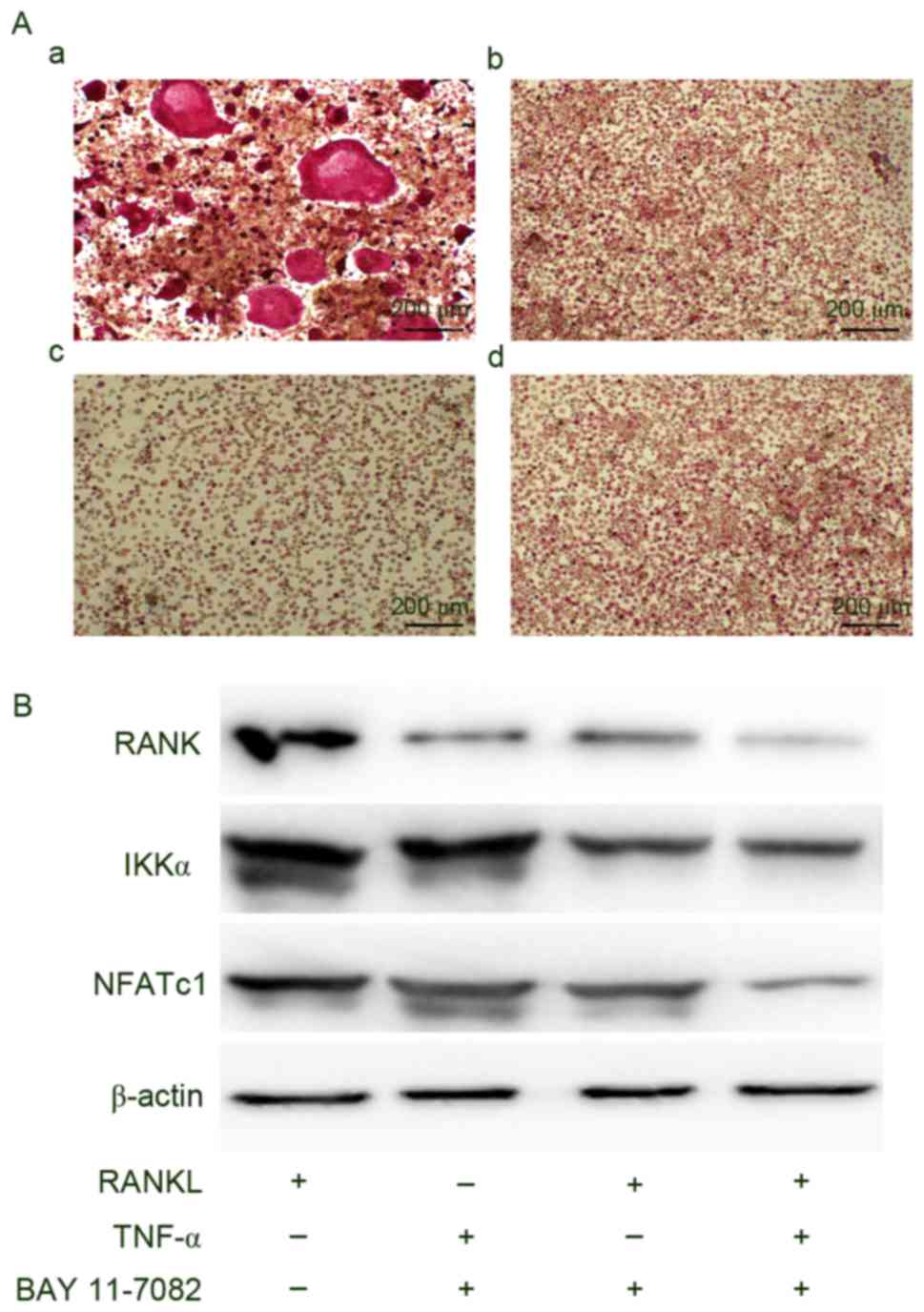TNF‑α and RANKL promote osteoclastogenesis by upregulating RANK via the NF‑κB pathway
- Authors:
- Published online on: March 7, 2018 https://doi.org/10.3892/mmr.2018.8698
- Pages: 6605-6611
-
Copyright: © Luo et al. This is an open access article distributed under the terms of Creative Commons Attribution License.
Abstract
Introduction
Osteoclastogenesis and osteoblastogenesis must be properly balanced for bone homeostasis to be maintained (1,2), and abnormal activation of osteoclasts has been identified in a variety of bone diseases, such as osteoporosis, osseous metastasis and arthritis, which are associated with pathologic bone resorption. Some studies (3,4) have been conducted to investigate how various inflammatory cytokines drive excessive bone loss by suppressing the anabolic functions of osteoblasts and inducing receptor activator of nuclear factor (NF)-κB ligand (RANKL) expression in the osteoblast lineage and stromal cells, thereby promoting osteoclastogenesis. These studies have demonstrated that inflammatory cytokines such as tumor necrosis factor alpha (TNF-α) and interleukin-1 can act in concert with RANKL to augment signaling by RANK and directly promote osteoclastogenesis, but the underlying molecular mechanism remains unclear (5,6).
Osteoclast precursors are derived from hematopoietic stem cells identified in the bone marrow and are the only cells capable of bone resorption (7). Thus, these cells are required for both normal bone homeostasis and pathological bone loss. Their differentiation and activation are regulated by a variety of hormones and cytokines. In particular, RANKL and macrophage colony-stimulating factor (M-CSF) were demonstrated to be essential cytokines for osteoclast differentiation (8). RANKL is a member of the TNF superfamily, and through its receptor RANK, RANKL acts as the primary cytokine mediating osteoclast differentiation by inducing fusion of preosteoclasts to produce mature multinucleated cells (9,10). Binding between RANKL and RANK on preosteoclasts leads to the recruitment of TNF receptor-associated factor (TRAF) family proteins, such as TRAF2/6, which activate mitogen-activated protein kinases, as well as NF-κB (11). This signaling activates transcription factors that are required for osteoclast differentiation, such as c-Fos, activator protein-1 and nuclear factor of activated T cells 1 (NFATc1) (12,13) Stimulation with RANKL selectively induces NFATc1 expression, and thus, NFATc1 is considered to function as a master switch for controlling the terminal differentiation of osteoclasts (14).
TNF-α is known to be among the most potent multifunctional inflammatory cytokines. By inducing macrophage cell killing activity, TNF-α serves an important role in the host immune response (15). In addition, TNF-α has been demonstrated to be involved in bone resorption associated with inflammatory diseases of bone (16,17). TNF-α can influence osteoclast precursor differentiation and bone resorption activity through various processes, one of which is the induction of RANKL and M-CSF expression within osteogenic cells, which indirectly promotes the differentiation and function of osteoclasts (18). Another process involves the direct induction of preosteoclast fusion and differentiation, but the specific underlying mechanisms have not been elucidated (19).
To investigate the molecular mechanism underlying the positive effects of TNF-α on RANKL-induced osteoclast differentiation, then the authors examined the activation of the NF-κB pathway and the expression of RANK during the course of osteoclastogenesis in bone marrow-derived macrophages (BMMs). The results of the present study indicated that TNF-α promotes osteoclast precursor differentiation by working together with RANKL and upregulating RANK expression.
Materials and methods
Cell culture and reagents
The growth medium for primary mouse BMMs was α-minimum essential medium (Gibco; Thermo Fisher Scientific, Inc., Waltham, MA, USA) supplemented with 10% fetal bovine serum (FBS; Gibco; Thermo Fisher Scientific, Inc.) and antibiotics (100 U/ml penicillin and 100 g/ml streptomycin, Gibco; Thermo Fisher Scientific, Inc.). Recombinant murine M-CSF and recombinant murine soluble RANKL were purchased from PeproTech, Inc. (Rocky Hill, NJ, USA). Tartrate-resistant acid phosphatase (TRAP) staining solution 387-A was purchased from Sigma-Aldrich; Merck KGaA (Darmstadt, Germany), and the Cell Counting Kit-8 (CCK-8), a TRAP assay kit (cat. no. P0332) and an inhibitor of NF-κB (BAY 11–7082) were purchased from Beyotime Institute of Biotechnology (Haimen, China). For reverse transcription-quantitative polymerase chain reaction (RT-qPCR), TaqMan® gene expression assays were conducted with Reverse Transcriptase qPCR™ Mastermix No-ROX from Promega Corporation (Madison, WI, USA). Primary antibodies to RANK (sc-59981; 1:500), NF-κB (sc-166588; 1:100), and NFATc1 (sc-7294; 1:3,000) were obtained from Santa Cruz Biotechnology, Inc. (Dallas, TX, USA).
Isolation of BMMs and in vitro induction of osteoclastogenesis
A total of 20 C57BL/6 mice (weighing approximately 18–22 g) were obtained from the Animal Experiment Laboratory of Daping Hospital (Chongqing, China). All mice were fed ad libitum with standard rodent chow and had free access to food and water (Prolab RMH 3000; PMI LabDiet, Richmond, IN, USA). All experiments involving mice were approved by the Institutional Animal Care and Use Committee at the Third Military Medical University (Chongqing, China). Femurs and tibiae were removed from 6-week-old male C57BL/6 mice following sacrificed the mice by cervical dislocation. Bone marrow cells were collected, treated with red blood cell lysis buffer (150 mM ammonium chloride, 10 mM potassium bicarbonate and 0.1 mM EDTA, pH 7.4), and then cultured in growth medium containing M-CSF (10 ng/ml) in 5% CO2 at 37°C. Following incubation overnight, nonadherent cells were collected, seeded at 5×107 cells per well in 6-well plates, and treated with M-CSF (30 ng/ml) for a further 48 h. Then the cells that adhered to the plates were used as BMMs, and cells that continued to be nonadherent were washed away. Detachin™ (Genlantis, San Diego, CA, USA) was used for cell detachment, and, upon resuspension, the obtained cells were seeded on dishes or plates for induction of osteoclastogenesis. To induce osteoclastic differentiation, BMMs (1×105 cells/ml) were cultured in growth media containing 30 ng/ml M-CSF and 50 ng/ml RANKL with or without TNF-α at various concentrations for 4 days.
Cell viability assay
BMMs were cultured in growth media containing 30 ng/ml M-CSF in the presence or absence of TNF-α (0, 10, 20, 40, 80, 100 or 200 µM) for 4 days. Cell viability was assessed using CCK-8, according to the manufacturer's instructions. Briefly, the cells were plated in 96-well plates at 1×104 cells per well and cultured in growth medium. At the indicated time points, cells were incubated with CCK-8 solution for 4 h at 37°C. The viability of cells was assessed by measuring the absorbance at 450 nm using the Biotek ELX-800 plate reader (Biotek Instruments, Inc., Winooski, VT, USA). All experiments were performed in triplicate.
Measurement of TRAP activity and TRAP staining
BMMs (1×105 cells/well) were seeded in wells of 24-well plates and incubated for 24 h prior to treatment with 10 ng/ml M-CSF for 2 days followed by treatment with 30 ng/ml M-CSF + 50 ng/ml RANKL in media containing 10% FBS for 4 days. Following incubation, the cells were fixed in 3.7% formaldehyde, permeabilized with 0.1% Triton X-100 and incubated with TRAP staining solution 387-A in the dark at 37°C. Following rinsing the cells, TRAP-positive multinucleated cells were visualized by phase-contrast light microscopy (Olympus Corporation, Tokyo, Japan). Following staining, TRAP-positive multinucleated cells (3 nuclei) were counted manually in six randomly selected visual fields. TRAP activity was assessed using a TRAP staining kit and absorbance measurement at 540 nm.
RT-qPCR
Briefly, total RNA was extracted on the indicated days using TRIzol reagent (Invitrogen; Thermo Fisher Scientific, Inc.), and purified total RNA was used for cDNA synthesis with Moloney murine leukemia virus (M-MLV) reverse transcriptase and oligo(dT) primers (Promega Corporation). The specific primer pairs are listed in Table I. Nfatc1 and other mRNAs were measured using the StepOne real-time PCR system (Applied Biosystems; Thermo Fisher Scientific, Inc.). The PCR program involved an initial step for 20 sec at 95°C, followed by 40 thermal cycles of 3 sec at 95°C and 30 sec at 60°C, and finished with 15 sec at 95°C, 1 min at 60°C and 15 sec at 95°C. Data were analyzed according to the comparative cycle threshold method (20) and were normalized to GAPDH expression in each sample. The expression of individual genes was assessed in triplicate samples and repeated each experiment at least three times.
Immunostaining
For immunostaining analysis, BMMs were fixed in 4% paraformaldehyde and permeabilized with 0.1% Triton X-100 for 30 min. Cells were rinsed again with PBS and blocked with 5% bovine serum albumin, washed three times with PBS prior to incubation with the primary antibody against RANK (dilution 1:300) at 4°C overnight. Cells stained with RANK were then visualized following incubation with a fluorescein isothiocyanate-conjugated secondary antibody (A0568; 1:500; Beyotime Institute of Biotechnology, Haimen, China) for 2 h at room temperature and treatment with 50 µg/ml DAPI for nuclear staining. Fluorescence images were obtained using a fluorescence microscope (Fluoview 400; Olympus Corporation).
Western blot analysis
Cell lysates were prepared using radioimmunoprecipitation assay buffer [50 mM Tris-Cl (pH 7.4), 150 mM NaCl, 1% NP-40, 0.25% Na-deoxycholate, 0.1% SDS with 1 mM EDTA (pH 8.0), 1 mM phenylmethylsulfonyl fluoride, 2 µg/ml aprotinin, 2 µg/ml leupeptin, 4 mM Na3VO4 and 10 mM NaF]. The samples (10–30 µg protein/well) were resolved using SDS-PAGE (6–10% gels), and proteins were transferred to nitrocellulose membranes. The membranes were blocked in 5% skim milk and incubated with antibodies against NFATc1 (1:3,000), RANK (1:500), IκB kinase α (sc-1643; 1:1,000) and α-tubulin (sc-69970; 1:500) at 4°C overnight. Next, the membranes were incubated with a horseradish peroxidase-conjugated secondary antibody rabbit anti-mouse IgG H&L (ab6728; Abcam, Cambridge, MA, USA) at a dilution of 1:300 for 3 h at 4°C. Protein bands were visualized with an enhanced chemiluminescence detection kit (Roche Diagnostics, Basel, Switzerland). Chemiluminescence was detected using a motorized molecular imaging system (GE Healthcare, USA).
Statistical analysis
Unless otherwise specified, the results are presented as mean ± standard deviation. Statistical comparisons were performed using Student's t-tests, and P<0.05 was considered to indicate a statistically significant difference.
Results
Effect of TNF-α on BMM viability
The authors first investigated whether specific concentrations of TNF-α may be cytotoxic to BMMs in culture. Following treatment with TNF-α at concentrations between 0 and 200 µg/µl for 4 days, BMMs remained viable in general (Fig. 1). However, the effect of TNF-α on BMM viability was indicated to be dose dependent. At concentrations of ≤40 µg/µl, TNF-α positively affected the viability of BMMs, inducing BMM proliferation, whereas BMMs treated with higher doses of TNF-α presented less activity with the CCK-8 assay, although still more than that of cells not exposed to TNF-α. Therefore, the authors selected 40 µg/µl TNF-α as the appropriate concentration for stimulation of BMMs.
TNF-α promotes osteoclast formation and fusion from BMMs
The effects of TNF-α on osteoclast formation were analyzed among BMMs in vitro by treating BMMs with RANKL and M-CSF in the presence or absence of TNF-α. TNF-α treatment promoted osteoclast formation as indicated by an increase in the number of TRAP-positive multinucleated osteoclasts (Fig. 2A). Large TRAP-positive multinucleated osteoclasts (≥10 nuclei) were clearly observed in the TNF-α-treated group (Fig. 2B). In addition, the TRAP activity of BMMs induced by RANKL was further promoted by TNF-α (Fig. 2C). These results indicated that TNF-α promotes osteoclast formation and fusion.
TNF-α and RANKL together upregulate expression of genes related to osteoclastogenesis
To explore the molecular mechanism underlying the promotion of osteoclast formation and fusion by TNF-α, the authors analyzed the mRNA levels of genes related to osteoclast differentiation, specifically RANK, NFATc1 and NF-κB, in BMMs exposed to TNF-α, RANKL or both. The mRNA levels of RANK and NFATc1 were increased by varying degrees by TNF-α (Fig. 3). Furthermore, the synergistic actions of TNF-α and RANKL may be reflected by the activation of NFATc1 signaling, which is essential for osteoclastogenesis, unlike NF-κB signaling. Notably, together TNF-α and RANKL induced upregulation of RANK.
TNF-α and RANKL increase expression of RANK in BMMs
To confirm that TNF-α and RANKL together increase the expression of RANK, RANK expression was assessed in BMMs exposed to TNF-α, RANKL or both, via immunofluorescence. The results demonstrated that either TNF-α or RANKL may upregulate the expression of RANK, yet exposure to both cytokines led to even greater expression of RANK (Fig. 4).
Inhibition of NF-κB signaling prevents osteoclastogenesis even with stimulation by TNF-α and/or RANKL
Finally, the authors examined whether the NF-κB signaling pathway participates in osteoclastogenesis among BMMs using BAY 11–7082, a specific inhibitor of NF-κB. The addition of BAY 11–7082 to BMMs in culture medium containing TNF-α, RANKL or both resulted in the suppression of osteoclastogenesis and downregulation of IKKα, NFATc1 and RANK expression (Fig. 5).
Discussion
Bone undergoes continuous renewal, which requires a precise balance of bone resorption and formation. Bone resorption by osteoclasts is known to be largely mediated by inflammatory cytokines including TNF-α, which has been indicated to modulate a broad spectrum of responses including inflammation, proliferation, apoptosis, immunoregulation and antiviral activity at the cellular level (21). In bone, TNF-α inhibits extracellular matrix deposition and stimulates matrix metalloprotease synthesis. Moreover, previous studies have demonstrated that TNF-α can be used to induce bone resorption both in vitro and in vivo (22,23). To better understand the molecular mechanisms underlying the functions of TNF-α in osteoclast differentiation, the authors examined the activation of specific signaling pathways and the expression of RANK and other osteogenic factors during the course of osteoclastogenesis induced by M-CSF and RANKL with or without TNF-α.
Initially, the viability of BMMs exposed to various concentrations of TNF-α was examine in culture and concentrations of TNF-α that were nontoxic to BMMs were identified. In addition, greater activity among cells treated with TNF-α at concentrations of ≤40 µg/µl was observed. However, all BMMs treated with TNF-α presented greater viability than control cells not treated with TNF-α. These data suggested that TNF-α can influence on the viability of BMMs directly and were distributed normally between the effect and concentration. Following this, whether TNF-α could stimulate osteoclastic differentiation of BMMs with or without RANKL was analyzed. The current results demonstrated that TNF-α could not induce osteoclastogenesis of BMMs without RANKL, but did enhance osteoclastogenesis when delivered with RANKL, as confirmed by increased numbers of TRAP-positive multinucleated osteoclasts and increased TRAP activity. Nevertheless, the osteoclastogenic effect of TNF-α independent of RANKL has been controversial, with studies reporting that TNF-α directly promotes osteoclast formation in vitro in the absence of RANKL (21,24). In contrast to the present approach, peripheral blood mononuclear cells (PBMCs) were isolated from whole blood of psoriatic arthritis patients as the target cells treated with TNF-α, which then led to the observation of an enhanced osteoclastogenic effect with TNF-α alone. In contrast, the authors suggested that PBMCs should be seen as the cells to be pretreated with various cytokines. However, consistent with the present findings, another study reported that TNF-α does not induce osteoclastogenesis without RANKL. Moreover, Li et al (25) demonstrated that administration of TNF-α to RANK-deficient mice is not able to induce osteoclastogenesis in vivo. The current results further support that TNF-α cannot serve as a substitute for RANKL toward the induction of osteoclastogenesis in physiological conditions.
Previous studies have indicated that TNF-α increases the production of osteoclastogenic cytokines, such as M-CSF and RANKL in osteoblast-like cells (26,27). Therefore, TNF-α likely promotes the differentiation of osteoclast precursors, thereby supporting bone resorption. To further investigate the molecular mechanisms by which TNF-α induces osteoclastogenesis, the authors evaluated the mRNA expression of RANK, NFATc1 and NF-κB in BMMs exposed to TNF-α and RANKL individually or in combination using RT-qPCR. The results indicated that both TNF-α and RANKL individually upregulated the expression of RANK and NFATc1, indicating the potential for similar activities between these cytokines. Moreover, greater increases in the expression of RANK and NFATc1, as well as increased NF-κB expression, were observed upon treatment of BMMs with both TNF-α and RANKL. The increased expression of RANK mRNA substantiated matching trends in the intensity of immunofluorescent staining of RANK in BMMs treated with TNF-α and RANKL individually or in combination.
The present findings suggested that RANKL and TNF-α function in concert in the osteoclastogenic process. Therefore, the authors sought to determine whether this coordinated activity is reflected in a signaling pathway essential for osteoclast differentiation. When RANKL binds to its receptor RANK on osteoclasts, activation of the NF-κB signaling pathway is one critical distal event in osteoclastogenesis (28). To determine whether TNF-α also activates the same signaling pathways as RANKL in the cytoplasm, a specific inhibitor of NF-κB (BAY 11–7082) was used to block the pathway. The results indicated that blocking the NF-κB pathway inhibited the formation of osteoclasts as well as the upregulation of RANK, IKKα and NFATc1 typically observed during osteoclastogenesis. Thus, the NF-κB pathway may represent a target for interrupting bone absorption caused by chronic inflammation.
The current results confirm that the relationship between TNF-α and RANKL in osteoclastogenesis is intricate. Both factors, individually and in combination, have major effects on osteoclast progenitors. The current data for the role of TNF-α in inflammatory osteolysis indicate that TNF-α acts on the stromal environment to enhance expression of osteoclastogenic factors, thereby increasing osteoclast differentiation. These results demonstrate that TNF-α alone cannot induce BMM differentiation into osteoclasts, but TNF-α may directly stimulate BMM synthesis of RANK and other osteoclastogenic cytokines, as well as amplify the effects of RANKL via NF-κB signaling. Therefore, the NF-κB pathway may represent a potential target for preventing osteoporosis and arthritis caused by chronic inflammatory factors, such as TNF-α.
Acknowledgements
The authors gratefully acknowledge all of the members of the laboratory for sharing reagents and advice.
Funding
The present study was supported by the Ministry of Science and Technology (grant no. 011cb964701).
Availability of data and materials
All data generated or analyzed during this study are included in this published article.
Authors' contributions
ZGW and BZ planned the study. GL, FL and XL conducted the experiments. GL analyzed the data and wrote the manuscript. All authors read and approved the final manuscript.
Ethics approval and consent to participate
All experiments involving mice were approved by the Institutional Animal Care and Use Committee at the Third Military Medical University (Chongqing, China).
Consent for publication
Not applicable.
Competing interests
The authors declare they have no competing interests.
References
|
Rodan GA: The development and function of the skeleton and bone metastases. Cancer. 97:726–732. 2003. View Article : Google Scholar : PubMed/NCBI | |
|
Tanaka Y, Nakayamada S and Okada Y: Osteoblasts and osteoclasts in bone remodeling and inflammation. Curr Drug Targets Inflamm Allergy. 4:325–328. 2005. View Article : Google Scholar : PubMed/NCBI | |
|
Pathak JL, Bravenboer N, Verschueren P, Lems WF, Luyten FP, Klein-Nulend J and Bakker AD: Inflammatory factors in the circulation of patients with active rheumatoid arthritis stimulate osteoclastogenesis via endogenous cytokine production by osteoblasts. Osteoporos Int. 25:2453–2463. 2014. View Article : Google Scholar : PubMed/NCBI | |
|
Jules J and Feng X: In vitro investigation of the roles of the proinflammatory cytokines tumor necrosis factor-alpha and interleukin-1 in murine osteoclastogenesis. Methods Mol Biol. 1155:109–123. 2014. View Article : Google Scholar : PubMed/NCBI | |
|
Córdova LA, Trichet V, Escriou V, Rosset P, Amiaud J, Battaglia S, Charrier C, Berreur M, Brion R, Gouin F, et al: Inhibition of osteolysis and increase of bone formation after local administration of siRNA-targeting RANK in a polyethylene particle-induced osteolysis model. Acta Biomater. 13:150–158. 2015. View Article : Google Scholar : PubMed/NCBI | |
|
Weitzmann MN: The Role of inflammatory cytokines, the RANKL/OPG axis, and the immunoskeletal interface in physiological bone turnover and osteoporosis. Scientifica (Cairo). 2013:1257052013.PubMed/NCBI | |
|
Gallois A, Lachuer J, Yvert G, Wierinckx A, Brunet F, Rabourdin-Combe C, Delprat C, Jurdic P and Mazzorana M: Genome-wide expression analyses establish dendritic cells as a new osteoclast precursor able to generate bone-resorbing cells more efficiently than monocytes. J Bone Miner Res. 25:661–672. 2010. View Article : Google Scholar : PubMed/NCBI | |
|
De Vries TJ, Schoenmaker T, Aerts D, Grevers LC, Souza PP, Nazmi K, van de Wiel M, Ylstra B, Lent PL, Leenen PJ and Everts V: M-CSF priming of osteoclast precursors can cause osteoclastogenesis-insensitivity, which can be prevented and overcome on bone. J Cell Physiol. 230:210–225. 2015. View Article : Google Scholar : PubMed/NCBI | |
|
Kim HJ, Yoon HJ, Kim SY and Yoon YR: A medium-chain fatty acid, capric acid, inhibits RANKL-induced osteoclast differentiation via the suppression of NF-kappaB signaling and blocks cytoskeletal organization and survival in mature osteoclasts. Mol Cells. 37:598–604. 2014. View Article : Google Scholar : PubMed/NCBI | |
|
Choi J, Choi SY, Lee SY, Lee JY, Kim HS, Lee SY and Lee NK: Caffeine enhances osteoclast differentiation and maturation through p38 MAP kinase/Mitf and DC-STAMP/CtsK and TRAP pathway. Cell Signal. 25:1222–1227. 2013. View Article : Google Scholar : PubMed/NCBI | |
|
Lampiasi N, Russo R and Zito F: The alternative faces of macrophage generate osteoclasts. Biomed Res Int. 2016:90896102016. View Article : Google Scholar : PubMed/NCBI | |
|
Ishida N, Hayashi K, Hoshijima M, Ogawa T, Koga S, Miyatake Y, Kumegawa M, Kimura T and Takeya T: Large scale gene expression analysis of osteoclastogenesis in vitro and elucidation of NFAT2 as a key regulator. J Biol Chem. 277:41147–41156. 2002. View Article : Google Scholar : PubMed/NCBI | |
|
Johnson RS, Spiegelman BM and Papaioannou V: Pleiotropic effects of a null mutation in the c-fos proto-oncogene. Cell. 71:577–586. 1992. View Article : Google Scholar : PubMed/NCBI | |
|
Takayanagi H, Kim S, Koga T, Nishina H, Isshiki M, Yoshida H, Saiura A, Isobe M, Yokochi T and Inoue J: Induction and activation of the transcription factor NFATc1 (NFAT2) integrate RANKL signaling in terminal differentiation of osteoclasts. Dev Cell. 3:889–901. 2002. View Article : Google Scholar : PubMed/NCBI | |
|
Danks L and Takayanagi H: Immunology and bone. J Biochem. 154:29–39. 2013. View Article : Google Scholar : PubMed/NCBI | |
|
Almeida M, Han L, Ambrogini E, Weinstein RS and Manolagas SC: Glucocorticoids and tumor necrosis factor α increase oxidative stress and suppress Wnt protein signaling in osteoblasts. J Biol Chem. 286:44326–44335. 2011. View Article : Google Scholar : PubMed/NCBI | |
|
Dong J, Cui X, Jiang Z and Sun J: MicroRNA-23a modulates tumor necrosis factor-alpha-induced osteoblasts apoptosis by directly targeting Fas. J Cell Biochem. 114:2738–2745. 2013. View Article : Google Scholar : PubMed/NCBI | |
|
Garcia-Lopez S, Villanueva R and Meikle MC: Alterations in the Synthesis of IL-1β, TNF-α, IL-6, and their downstream targets RANKL and OPG by mouse calvarial osteoblasts in vitro: Inhibition of bone resorption by cyclic mechanical strain. Front Endocrinol (Lausanne). 4:1602013.PubMed/NCBI | |
|
Lin NY, Stefanica A and Distler JH: Autophagy: A key pathway of TNF-induced inflammatory bone loss. Autophagy. 9:1253–1255. 2013. View Article : Google Scholar : PubMed/NCBI | |
|
Livak KJ and Schmittgen TD: Analysis of relative gene expression data using real-time quantitative PCR and the 2(-Delta Delta C(T)) method. Methods. 25:402–408. 2001. View Article : Google Scholar : PubMed/NCBI | |
|
Kitaura H, Kimura K, Ishida M, Kohara H, Yoshimatsu M and Takano-Yamamoto T: Immunological reaction in TNF-α-mediated osteoclast formation and bone resorption in vitro and in vivo. Clin Dev Immunol. 2013:1818492013. View Article : Google Scholar : PubMed/NCBI | |
|
Mukai T, Ishida S, Ishikawa R, Yoshitaka T, Kittaka M, Gallant R, Lin YL, Rottapel R, Brotto M, Reichenberger EJ and Ueki Y: SH3BP2 cherubism mutation potentiates TNF-α -induced osteoclastogenesis via NFATc1 and TNF-α -mediated inflammatory bone loss. J Bone Miner Res. 29:2618–2635. 2014. View Article : Google Scholar : PubMed/NCBI | |
|
Osta B, Benedetti G and Miossec P: Classical and paradoxical effects of TNF-alpha on bone homeostasis. Front Immunol. 5:482014. View Article : Google Scholar : PubMed/NCBI | |
|
Ritchlin CT, Haas-Smith SA, Li P, Hicks DG and Schwarz EM: Mechanisms of TNF-alpha- and RANKL-mediated osteoclastogenesis and bone resorption in psoriatic arthritis. J Clin Invest. 111:821–831. 2003. View Article : Google Scholar : PubMed/NCBI | |
|
Li J, Sarosi I, Yan XQ, Morony S, Capparelli C, Tan HL, McCabe S, Elliott R, Scully S, Van G, et al: RANK is the intrinsic hematopoietic cell surface receptor that controls osteoclastogenesis and regulation of bone mass and calcium metabolism. Proc Natl Acad Sci USA. 97:pp. 1566–1571. 2000; View Article : Google Scholar : PubMed/NCBI | |
|
Yu Y, Yang D, Qiu L, Okamura H, Guo J and Haneji T: Tumor necrosis factor-α induces interleukin-34 expression through nuclear factor-κB activation in MC3T3-E1 osteoblastic cells. Mol Med Rep. 10:1371–1376. 2014. View Article : Google Scholar : PubMed/NCBI | |
|
Xiong J, Piemontese M, Thostenson JD, Weinstein RS, Manolagas SC and O'Brien CA: Osteocyte-derived RANKL is a critical mediator of the increased bone resorption caused by dietary calcium deficiency. Bone. 66:146–154. 2014. View Article : Google Scholar : PubMed/NCBI | |
|
Swarnkar G and Abu-Amer Y: Regulation of NF-κB signaling in osteoclasts and myeloid progenitors. Methods Mol Biol. 1280:527–542. 2015. View Article : Google Scholar : PubMed/NCBI |



